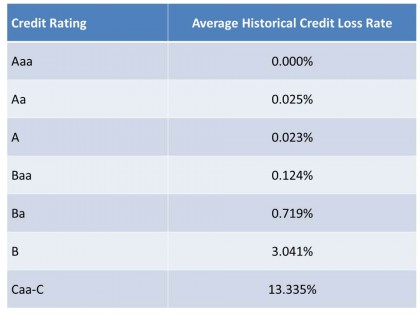Building Bond Ladders

Are you looking for a financial strategy that can deliver predictable cash flow along with the flexibility to customize an income stream to your needs? If so, a bond ladder may be just what you were looking for.
What is a Bond Ladder?
A bond ladder is a portfolio of bonds that is constructed to generate cash that matches the investor’s income needs, delivering the amount of cash needed at the time that it is needed. The basic idea is to “match” the timing of cash from your assets (the bonds) to the timing of your cash needs (your expenses).
How to Build a Bond Ladder
The basic steps required to build a bond ladder are:
- Estimate future income needs
- Establish risk tolerance
- Identify bonds that are a good fit
- Systematically build the portfolio to match income needs
Let’s go through these steps in more detail, along with a simple example to demonstrate how it might work in practice.
1. Estimate Future Income Needs
This is step is not unique to bond ladders; in fact, any retirement income strategy will require this to be a first step. This involves examining the future lifestyle that you anticipate, how it may evolve over time, and estimating the cost to provide for this lifestyle each year (perhaps with a margin of safety). Be sure to consider the effect of inflation.
For a bond ladder, you may want to either leave a conservative “terminal value” at the end of the ladder to provide for income needs for a period of time in case you live beyond your life expectancy, or alternatively purchase longevity insurance that will start to pay an income benefit once the cash from the bond ladder has been exhausted.
Example: In our simple illustration, let’s assume we need $100,000 at the beginning of each year for the next five years.
2. Estimate Risk Tolerance
Risk tolerance is needed to identify a minimum acceptable credit rating for a bond to be eligible for your portfolio. Bonds with lower credit ratings will have a higher probability of default (that is, not paying their promised coupons and maturity amounts), but will also offer higher yields. The following table summarizes average annual historical credit losses on corporate bonds over the period 1982 through 2008, as compiled by Moody’s (please note that historical results may not be indicative of future results):
A useful way to define risk tolerance for a bond portfolio is to define how much of your portfolio that you would like to invest in at each credit rating (e.g. 20% in Aaa, 30% in Aa, etc.).
Example: We only want to hold bonds that are Aaa rated.
3. Identify Bonds that are a Good Fit
Finding bonds that are appropriate for your ladder involves not only identifying an acceptable distribution across credit ratings – we also must consider the maturity dates, to match the timing of cash with our income objectives, as well as other features.
Bonds may have features that introduce other risk and/or return features, including:
Coupon Schedule – bonds may have different frequencies of paying interest to bondholders. Typically, bonds make coupon payments twice per year; some bonds, however, do not make any payments until their maturity date. These “zero coupon bonds” are therefore purchased at a deeper discount to their maturity value, and pay a one-time cumulative interest payment at maturity.
Callability - a callable bond gives the issuer the unilateral right to repay the principal to the bondholder at a time prior to the schedule maturity date, usually after a specified period of time has elapsed. This can be advantageous to the issuer if interest rates decline in the future, and also increase the risk to the bondholder. As a result, callable bonds pay higher rates of interest than an otherwise comparable bond.
Convertability - a convertible bonds gives the bondholder the right to exchange their bond for a specified number of shares of common stock. This can be advantageous to bondholders if the price of the common stock increases; this option therefore results in lower yields to bondholders than an otherwise comparable bond.
When looking at how well the collective portfolio of bonds fits the objectives, it is important to consider what the distribution of credit ratings looks like at each maturity period – you don’t want to have a portfolio that will have a tendency to “drift” toward a higher or lower credit profile over time. Therefore, keeping a reasonably consistent mix by credit rating across each maturity period is helpful.
A couple of other points when identifying bonds that are a good fit:
- Be sure to have a well diversified portfolio, that spans across different industries and geographies. A good rule of thumb is to have bonds from at least 30 different institutions, and possibly fewer if you plan on holding bonds with high credit ratings.
- The yields and cash flow that is expected from each bond should be noted.
Example: We will use simple non-callable bonds that pay annual coupons at the end of each year (just to make the illustration easier to follow). The coupons and yields of each bond (we also assume that each bond can be purchased at a price equal to its maturity value) are as follows:
- 1 Year Bond = 1.00%
- 2 Year Bond = 2.00%
- 3 Year Bond = 3.00%
- 4 Year Bond = 4.00%
4. Systematically Build the Portfolio to Meet Income Needs
Building your portfolio involves starting with your cash requirements in the later years, and working backwards. This is probably best understood by focusing on the example that we have created.
Example: Remember that we need $100,000 at the beginning of each year Starting at the beginning of year 5 (which is in 4 years from today) we will need to invest $96,153 in a 4 year bond so that it pays $100,000 at the end of the 4 year period (a maturity value of $96,153 plus interest paid at the end of the fourth year equal to 4% x $96,153, for a total of $100,000).
The 4 year bond will also generate cash at the end of each year equal to 4% x 96,153 = $3,846. This means that our investment 3 year bonds must generate cash equal to $100,000 – $3,846 = $96,154. Given that the interest rate on a 3 year bond is 3%, the amount that we must invest in 3 year bonds is equal to 96,154/1.03 = $93,353, where the 1.03 reflects the repayment of the original principal (1.00) plus interest (3%). Note that 1.03 x 93,353 = $96,154, our cash target.
Now, we repeat this process for the 2 year bond, realizing that we will be receiving a coupon of $3,846 from the 4 year bond along with a coupon of 93,353 x 3% = $2,800, for a total of $6,646. The investment in 2 year bonds must therefore generate cash of $100,000 – $6,646 = $93,354. At a 2% interest rate for 2 year bonds, we must therefore invest 93,354/1.02 = $91,523.
Finally, we can determine that for our 1 year bond, we will already be receiving coupons of 3,846+2,800+2% x 91,523 = $8,476, meaning that we need to generate cash of $100,000 – $8,476 = $91,524. We must therefore invest 91,524/1.01 = $90,618 in one year bonds.
And we are done! We have created a portfolio of bonds that will generate $100,00 of cash at the beginning of each of the next 5 years.
No Interest Rate Risk
Because the ladder is generating the cash that we need when we need it, we can plan on holding each bond to maturity without having to buy or sell bonds over the 5-year period. As a result, there is no exposure to interest rate risk, as future interest rates will not affect the cash flow of this arrangement. It is completely determined by current interest rates. For more information on bonds and interest rate risk, read our other posting on “Bonds & Interest Rate Risk“.
Advantages of Bond Ladders
Advantage #1 They can generate predictable levels of cash, particularly when invested in high-quality bonds.
Advantage #2 You have control of the assets, eliminating the risk of a misalignment of interests between you and the portfolio manager.
Advantage #3 Minimal interest rate risk, if designed properly.
Disadvantages of Bond Ladders
Disadvantage #1 Today’s low interest rates mean you will either need to tighten your belt substantially and reduce your spending, or take more risk than you otherwise would like to.
Disadvantage #2 Bond’s generally do not provide protection again inflation; in fact, bonds may increase your exposure to inflation risk with one exception – TIPs.
Disadvantage #3 There is a chance that you can live beyond the ladder period, and funding for longevity risk with a low yielding investment can be quite expensive. Consider purchasing longevity insurance to provide the income you will need in the later years of retirement.
Disadvantage #4 Selecting bonds is not easy and does require training and experience. It is probably a good idea to employ the services of a professional investment adviser who specializes in fixed income securities, if you do not have the technical background.
Posted by
John Bevacqua on November 9, 2011
Filed Under
Share This Post
The basic idea is to "match" the timing of cash from your assets (the bonds) to the timing of your cash needs (your expenses).
 Follow us on Twitter
Follow us on Twitter Follow us on Facebook
Follow us on Facebook